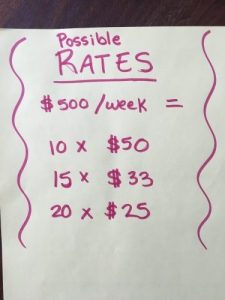Before you analyze your competition and current market prices there is one crucial foundational component of setting your rates to consider.
Many personal trainers set their rates based on a list of factors outside themselves, such as demographic area, target clientele, competing trainers in the same experience and educational bracket as themselves. These are important factors to consider when rate setting.
One other factor to calculate when setting your rates is YOU. If I were to purchase YOU on Amazon, what is your monthly price tag?
Before you ever set personal training rates do this.
Calculate your monthly total of your food, rent/mortgage, gas, car insurance, phone, internet, etc. These are called expenses. Do this by looking back on credit card statements or keeping track as you move forward. You can keep printed receipts and total them up, or log purchases every day in a spreadsheet.
Setting Your Personal Training Rates
Financial health is like exercise. The more aware and educated you are the more fit you are. Follow these steps to become more financially fit and set prices that support your needs.
1. Investigate your personal costs. Divide annual or bi-annual bills such as car insurance by 6 or 12 to get a monthly figure. Track your food costs for 1-3 months and get an average.
2. Calculate your session cost. Once you know your monthly price tag you can figure out how much you need to earn each week and each hour. If you need $2,000/month to pay all of your basic bills, that’s about $500/week.

$500/week can look like this:
- 10 clients at $50/hour
- 15 clients at $33/hour
- 20 clients at $25/hour
3. Factor in taxes. If $50/hour is how much you take home you still need to pay the government. We don’t want to take more money away from that $50 because you need it to live. So, let’s add more in and have the client pay that.
Taxes usually add another 20-25% to this number. Here’s how the price changes when you add 20% or 25% for taxes. You are adding it so that you can set your rate higher accordingly.
- $50 becomes $60 or $62.50
- $33 becomes $39.60 or $$41.25
- $25 becomes $30 or $31.25
4. Consider other costs. Continuing education, business cards, websites and advertising are costs that you may not currently have in your budget. It’s smart to have an emergency fund as well since you don’t get paid for time off or illness. If your monthly needs are $2,000 and your goal is to see 20 clients a week to cover basics. Keep in mind that your goal is to get 25 clients eventually for covering additional needs.
When you start a new business it’s expected to take 1-3 years at minimum to break even financially and sometimes more if you opened a gym with additional overhead costs.
5. Follow this golden advice. A wise mentor of mine once said, If you want to have 20 clients a week, put in 20 hours a week to education, networking and marketing yourself until you get to that number.
Setting a solid financial foundation for yourself before you set rates is a smart step in creating a business with longevity.
Here are 4 personal training package pricing ideas if you want to get creative beyond hourly rates.
[info type=”facebook”]Got questions about rates? We’ll try to help you out. If you’re an NFPT trainer, join the Facebook Community Group to chat with NFPT and other trainers. If you’re not certified yet, come talk with NFPT here, we would like to meet you![/info]
Beverly Hosford, MA teaches anatomy and body awareness using a skeleton named Andy, balloons, play-doh, ribbons, guided visualizations, and corrective exercises. She is an instructor, author, and a business coach for fitness professionals. Learn how to help your clients sleep better with in Bev's NFPT Sleep Coach Program and dive deeper into anatomy in her NFPT Fundamentals of Anatomy Course.

